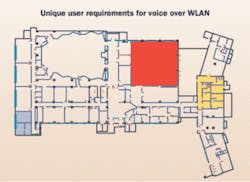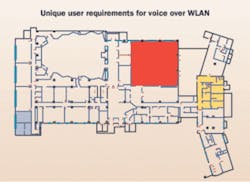Traditional and new network design methods have their pros and cons.
Voice over Wireless Fidelity (VoWi-Fi) presents a difficult challenge because introducing such high-bandwidth wireless applications can cause wireless networks to suffer a loss of quality of service (QoS)-and, in many cases, fail.
QoS is important because, according to a January report by Infonetics Research (www.infonetics.com), WiFi phone units grew 112% between 2004 and 2005, and will grow 158% in 2006.
The cold reality is that ad-hoc design methods and site surveys are insufficient for wireless networks supporting high-volume applications. Making matters worse, radio frequency (RF) interference, RF noise, and the physical environment dramatically affect wireless coverage and capacity. These challenges become exponentially more difficult to solve as the wireless network grows in size and complexity.
The approach you use to plan the wireless network can be the difference between a successful project and one fraught with problems. Many companies are now finding that the optimal way to address VoWi-Fi coverage and capacity is through intelligent wireless network design.
Here’s a review of some of the challenges, and potential solutions, for implementing VoWi-Fi coverage:
The physical environment
If you are experienced with wired networks and plan to implement VoWi-Fi, you must consider several issues. In a wired network, you can simply plug into a LAN socket to achieve connectivity. In a wireless network, seeing the wireless access point (WAP) does not necessarily mean that you can actually connect to it and achieve acceptable QoS.
Unlike a wired network, a wireless network depends on RF signal quality and network availability for communication. You must take into account the layout of your facility, such as the location and construction of walls, doors, and windows. These factors have a significant impact on wireless signals, causing them to leak outside the building, weakening them, causing interference, or even blocking them entirely, which creates coverage holes.
Because wireless communication relies on RF signals, there is a limited coverage area surrounding the WAP. You cannot expect a uniform wireless coverage pattern due to the physical environment shaping the signal. Walls, tinted glass windows, metal shelving, ceilings, and other physical obstructions block or impede wireless signals-a critical variable that you must take into account to achieve optimal VoWi-Fi performance.
Capacity and VoWi-Fi
When compared to a typical wired network, a WLAN has a lower bit rate-generally 11 to 54 Mbits/sec. This means that wireless networks provide less total capacity than a wired network.
But what is capacity and why is it important for VoWi-Fi? Wireless network capacity is the maximum amount of data or number of users that can simultaneously be on the network. The more users on the network, the more data you can expect the network to carry. Like cellular phone networks, if the amount of data exceeds the network’s capacity, roaming VoWi-Fi users will experience dropped or blocked calls.
Because each WAP has a maximum bandwidth, the total bandwidth divides across the number of users currently using that WAP. Each new wireless device connecting to the WAP causes the total bandwidth available for each user to shrink. This is especially critical when users add bandwidth-intensive applications, such as VoWi-Fi.
To satisfy high-bandwidth requirements, you can place WAPs with overlapping coverage, thereby increasing the available bandwidth within the overlap area. But this also introduces channel interference, which brings us to the challenges of meeting VoWi-Fi signal-to-interference ratio (SIR) requirements.
SIR and VoWi-Fi QoS
For VoWi-Fi applications to work properly, your wireless network must meet minimum RF quality levels. Specifically, VoWi-Fi phone manufacturers typically recommend that a wireless network maintain a 20 to 25 dB SIR to ensure high QoS.
For those new to wireless, SIR is the ratio of RF signal strength on a given frequency to the signal strength in another transmitter, such as a WAP, broadcasting on the same frequency. A WAP receiving a VoWi-Fi signal must detect signal strength 20 to 25 dB greater than the signal strength of the surrounding WAPs to guarantee QoS.
SIR becomes even more important when you have WAPs with overlapping channels. The most commonly used wireless network frequencies, 802.11b and 802.11g, have three unique channels on which WAPs can operate without any overlap of signal. Adding a fourth WAP into a coverage area, however, introduces channel interference because one of the frequencies must be re-used. Consequently, you must properly assign the channels and power levels so that WAP interference is minimized.
Another major variable affecting VoWi-Fi QoS is the signal-to-noise ratio (SNR), which is the ratio of RF signal strength to the background RF noise. This background noise, commonly called the environment’s “noise floor,” is generated by several sources including the AC grid, equipment in the building, and other unidentified sources. High RF noise levels are typically found in “RF-unfriendly” environments like medical facilities, which contain large amounts of electronic equipment. To guarantee high VoWi-Fi QoS, you must take into account SNR and SIR during wireless network design.
Why traditional methods fail
There are several commonly used methods for implementing a wireless network, but many of these techniques do not address all the issues associated with VoWi-Fi.
Ad hoc design. The ad hoc wireless design method is used to place WAPs into a dense grid. When QoS issues arise, you then add more WAPs. Unfortunately, this method is not cost-effective and may actually cause more problems than it solves. Specifically, there is no way to determine how many WAPs will ultimately be required to achieve high VoWi-Fi QoS.
Because ad hoc methods do not take into account the physical environment, you may be sending wireless services to areas where you may not want them-outside your building, for instance. In addition, the SIR 20 to 25 dB requirement still applies and is even more difficult to solve given the unpredictability and close proximity of ad-hoc WAP placement.
Site surveys. Wireless design methods, like site surveys, attempt to quantify through direct measurement the effect of the physical environment on wireless signal coverage. With this approach, WAPs are placed in a limited area, and then a site survey is performed by walking around and collecting wireless signal measurements. But a site survey only indicates signal activity at that location and at that moment in time; it cannot identify the dynamics of capacity issues, such as VoWi-Fi callers jumping on and off the network.
Because of the need to collect vast amounts of measurement data, iteratively place WAPs, set up channels, and balance capacity so that WAPs only supply signal to the correct clients, it is impossible to use the site survey-only method to design a robust, high-QoS VoWi-Fi network.
Connection limiting. Many wireless network designers attempt to solve VoWi-Fi capacity issues by limiting the number of users per WAP. The reality, however, is that VoWi-Fi users will be roaming around the building, requiring a continuous connection. Without having visibility into the anticipated number of users, impact of high-traffic regions, or impact of coverage overlaps on SNR, this approach makes QoS suffer from the dynamics of capacity fluctuations and RF quality issues.
Self-healing networks. A recent addition to the network designer’s toolbox, the self-healing wireless network, attempts to solve SIR, SNR, and coverage issues by dynamically configuring WAP channel settings and power levels. But if the self-healing process does not yield acceptable VoWi-Fi QoS, then more WAPs must be installed. Because self-healing techniques are not aware of the impact of the physical environment, channel and power setting adjustments can form coverage holes or send wireless signals outside the building. This places the wireless network in a continuous state of QoS flux since the WAP settings are constantly changing to meet requirements.
In summary, these wireless design methods often are insufficient for networks targeted for VoWi-Fi applications. In fact, the labor costs associated with these iterative approaches may actually be higher than the wireless network equipment costs.
Predictive simulation meets challenges
For many companies, wireless network design using predictive simulation software has become the optimal way to solve the VoWi-Fi coverage and capacity challenges. This method approaches the problem by looking at all of the variables that go into the network: the physical environment, SIR/SNR, signal coverage, and VoWi-Fi capacity requirements. Then, the software uses highly accurate simulations to predict and visualize the wireless network’s performance. Predictive simulation accommodates all of the RF variables and unknowns in advance, so that when the wireless network goes live, high VoWi-Fi QoS is assured.
With this innovative approach, the wireless network design process begins by importing data about a company’s facility into the software. Next, the software takes into account the physical environment by tagging each wall in the facility map with material types, such as sheetrock or brick, from a library of common building materials. Then, the designer places WAPs within the site map and simulates the coverage areas.
The software predicts the effects of physical obstructions and visually displays a coverage strength map, including SIR and SNR dB gradients. With this information, WAP placement and channel settings can be adjusted to satisfy the 20 to 25 dB SIR requirement.
Most importantly, the software makes designing for VoWi-Fi capacity efficient and predictable. You simply indicate expected client locations and bandwidth requirements within your environment. With this information, the simulation engine predicts whether the network capacity is sufficient, given the current WAP placement and configuration.ROGER SKIDMORE is a distinguished member of the technical staff at Motorola Inc. (www.motorola.com).

